Analysis of the Terminal Response Characteristics of the Twisted Three-Wire Cable Excited by a Plane Wave Field
Abstract
:1. Introduction
2. The Twisted Three-Wire Cable Triple Helix Structure Model
2.1. Twisted Three-Wire Cable Model in Cartesian Coordinate System
2.2. Unit Vector of the Twisted Three-Wire Cable
3. The Twisted Three-Wire Cable Terminal Response
3.1. Transmission-Line Equations of the Twisted Three-Wire Cable
3.2. Plane-Wave Excitation
3.3. Terminal Response of the Twisted Three-Wire Cable Equations
4. Simulation Verification
4.1. Effects of the Twisted Three-Wire Cable Length on Coupling Characteristics
4.2. Experimental Validation
- Cable Placement. A 1 m-long cable is placed on a horizontal table at a height of 1 m. The left and right ends are connected to a 50 Ω load resistance.
- Field Strength Calibration. An antenna is positioned 1 m away from the twisted three-wire cable to serve as a radiation excitation source. The field strength is marked at 2 V/m.
- System Setup: To monitor the load response at the right end, a single cable is passed through the current probe and then an optoelectronic conversion module is connected to the current probe at the right end of the load to convert the electrical signal of the load response into an optical signal. Another photoelectric conversion module is connected through optical fiber and connect it to the spectrum analyzer.
- The values are recorded. Another irradiation test is conducted without changing the field strength and record the response on the cable within the desired frequency band.
5. The Twisted Three-Wire Cable Characteristics Discussion
5.1. Effects of the Twisted Three-Wire Cable Length on Coupling Characteristics
5.2. Effects of the Twisted Three-Wire Cable Termination Load on Coupling Characteristics
5.3. Effects of the Twisted Three-Wire Cable Pitch on Coupling Characteristics
5.4. Response Comparison between the Twisted Three-Wire Cable and Parallel Three-Wire
6. Conclusions
Author Contributions
Funding
Data Availability Statement
Conflicts of Interest
References
- Zhou, L.; Zhang, S.; Yin, W.-Y.; Mao, J.-F. Immunity Analysis and Experimental Investigation of a Low-Noise Amplifier Using a Transient Voltage Suppressor Diode under Direct Current Injection of HPM Pulses. IEEE Trans. Electromagn. Compat. 2014, 56, 1715–1718. [Google Scholar] [CrossRef]
- Zhang, D.; Zhou, X.; Cheng, E.; Wan, H.; Chen, Y. Investigation on Effects of HPM Pulse on UAV’s Datalink. IEEE Trans. Electromagn. Compat. 2020, 62, 829–839. [Google Scholar] [CrossRef]
- van Leersum, B.; van der Ven, J.-K.; Bergsma, H.; Buesink, F.; Leferink, F. Protection Against Common Mode Currents on Cables Exposed to HIRF or NEMP. IEEE Trans. Electromagn. Compat. 2016, 58, 1297–1305. [Google Scholar] [CrossRef]
- Huangfu, Y.; Wang, S.; Di Rienzo, L.; Zhu, J. Radiated EMI Modeling and Performance Analysis of a PWM PMSM Drive System Based on Field-Circuit Coupled FEM. IEEE Trans. Magn. 2017, 53, 8208804. [Google Scholar] [CrossRef]
- Taylor, C.D.; Castillo, J.P. On the Response of a Terminated Twisted-Wire Cable Excited by a Plane-Wave Electromagnetic Field. IEEE Trans. Electromagn. Compat. 1980, EMC-22, 16–19. [Google Scholar] [CrossRef]
- Armenta, R.B.; Sarris, C.D. Efficient Evaluation of the Terminal Response of a Twisted-Wire Pair Excited by a Plane-Wave Electromagnetic Field. IEEE Trans. Electromagn. Compat. 2007, 49, 698–707. [Google Scholar] [CrossRef]
- Armenta, R.B.; Sarris, C.D. Modeling the Terminal Response of a Bundle of Twisted-Wire Pairs Excited by a Plane Wave. IEEE Trans. Electromagn. Compat. 2007, 49, 901–913. [Google Scholar] [CrossRef]
- Pignari, S.A.; Spadacini, G. Influence of twist-pitch random non-uniformity on the radiated immunity of twisted-wire pairs. In Proceedings of the 2011 XXXth URSI General Assembly and Scientific Symposium, Istanbul, Turkey, 13–20 August 2011; pp. 1–4. [Google Scholar] [CrossRef]
- Pignari, S.A.; Spadacini, G. Plane-Wave Coupling to a Twisted-Wire Pair Above Ground. IEEE Trans. Electromagn. Compat. 2011, 53, 508–523. [Google Scholar] [CrossRef]
- Spadacini, G.; Pignari, S.A. Numerical Assessment of Radiated Susceptibility of Twisted-Wire Pairs with Random Nonuniform Twisting. IEEE Trans. Electromagn. Compat. 2013, 55, 956–964. [Google Scholar] [CrossRef]
- Yuan, K.; Wang, J.; Xie, H.; Fan, R. SPICE Model of a Single Twisted-Wire Pair Illuminated by a Plane Wave in Free Space. IEEE Trans. Electromagn. Compat. 2015, 57, 574–583. [Google Scholar] [CrossRef]
- Yuan, K.; Wang, J.; Xie, H.; Fan, R. A Time-Domain Macromodel Based on the Frequency-Domain Moment Method for the Field-to-Wire Coupling. IEEE Trans. Electromagn. Compat. 2016, 58, 868–876. [Google Scholar] [CrossRef]
- Yuan, K.; Grassi, F.; Spadacini, G.; Pignari, S.A. Accounting for Wire Coating in the Modeling of Field Coupling to Twisted-Wire Pairs. IEEE Trans. Electromagn. Compat. 2018, 60, 284–287. [Google Scholar] [CrossRef]
- Gassab, O.; Yin, W.-Y. Characterization of Electromagnetic Wave Coupling with a Twisted Bundle of Twisted Wire Pairs (TBTWPs) above a Ground Plane. IEEE Trans. Electromagn. Compat. 2019, 61, 251–260. [Google Scholar] [CrossRef]
- Gassab, O.; Zhan, Q.; Zhou, L.; Yin, W.-Y. Transmission Line Model for a Shielded TWP with Apertures and Generalization to Braided–Shielded TWP Cables. IEEE Trans. Electromagn. Compat. 2021, 63, 2115–2123. [Google Scholar] [CrossRef]
- Zhao, M.; Chen, Y.; Zhou, X.; Zhang, D.; Nie, Y. Investigation on Falling and Damage Mechanisms of UAV Illuminated by HPM Pulses. IEEE Trans. Electromagn. Compat. 2022, 64, 1412–1422. [Google Scholar] [CrossRef]
- Paul, C.R. Analysis of Multiconductor Transmission Lines. Available online: http://www.researchgate.net/publication/241130019_Analysis_of_Multiconductor_Transmission_Lines (accessed on 6 October 2021).
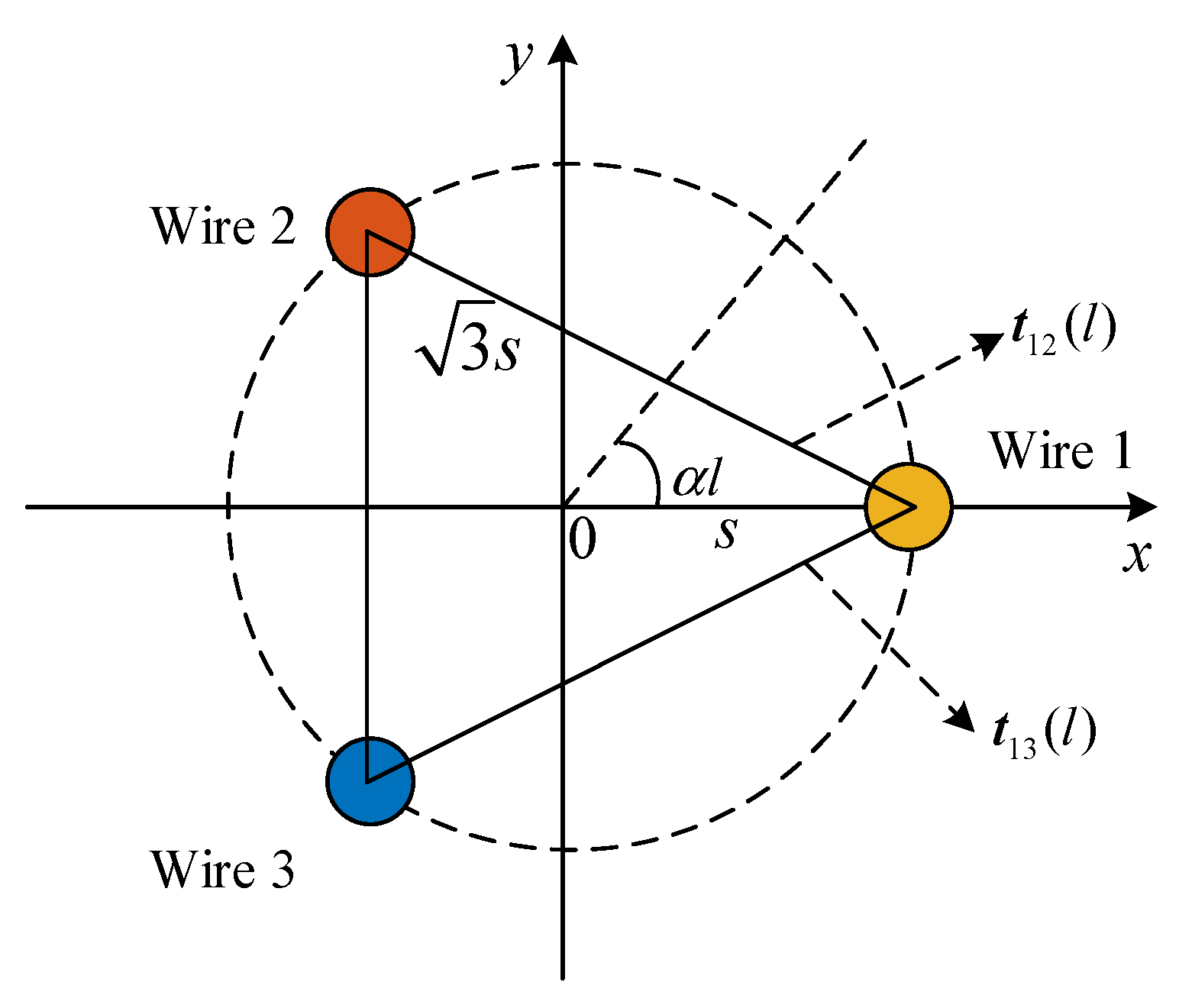
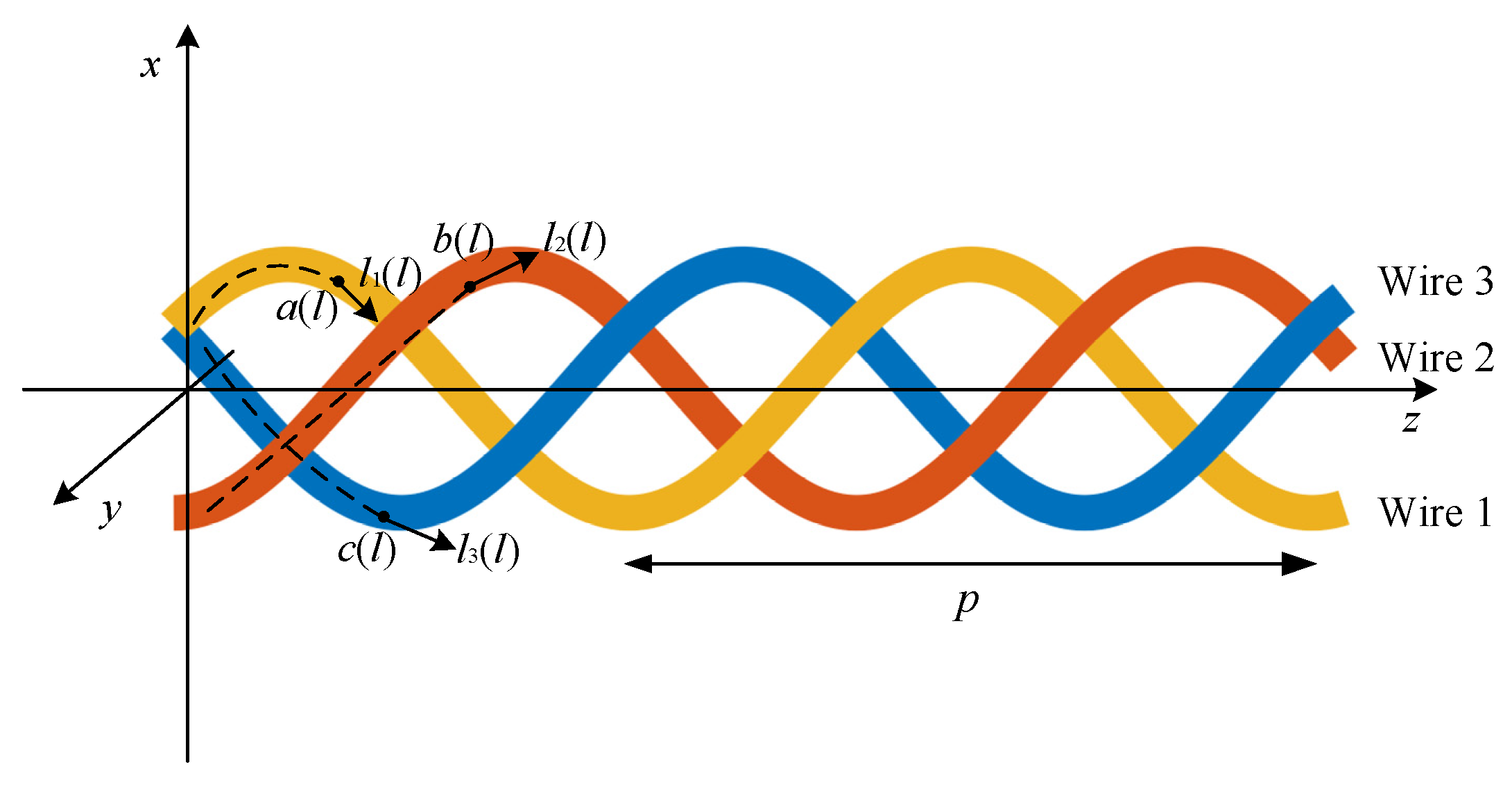
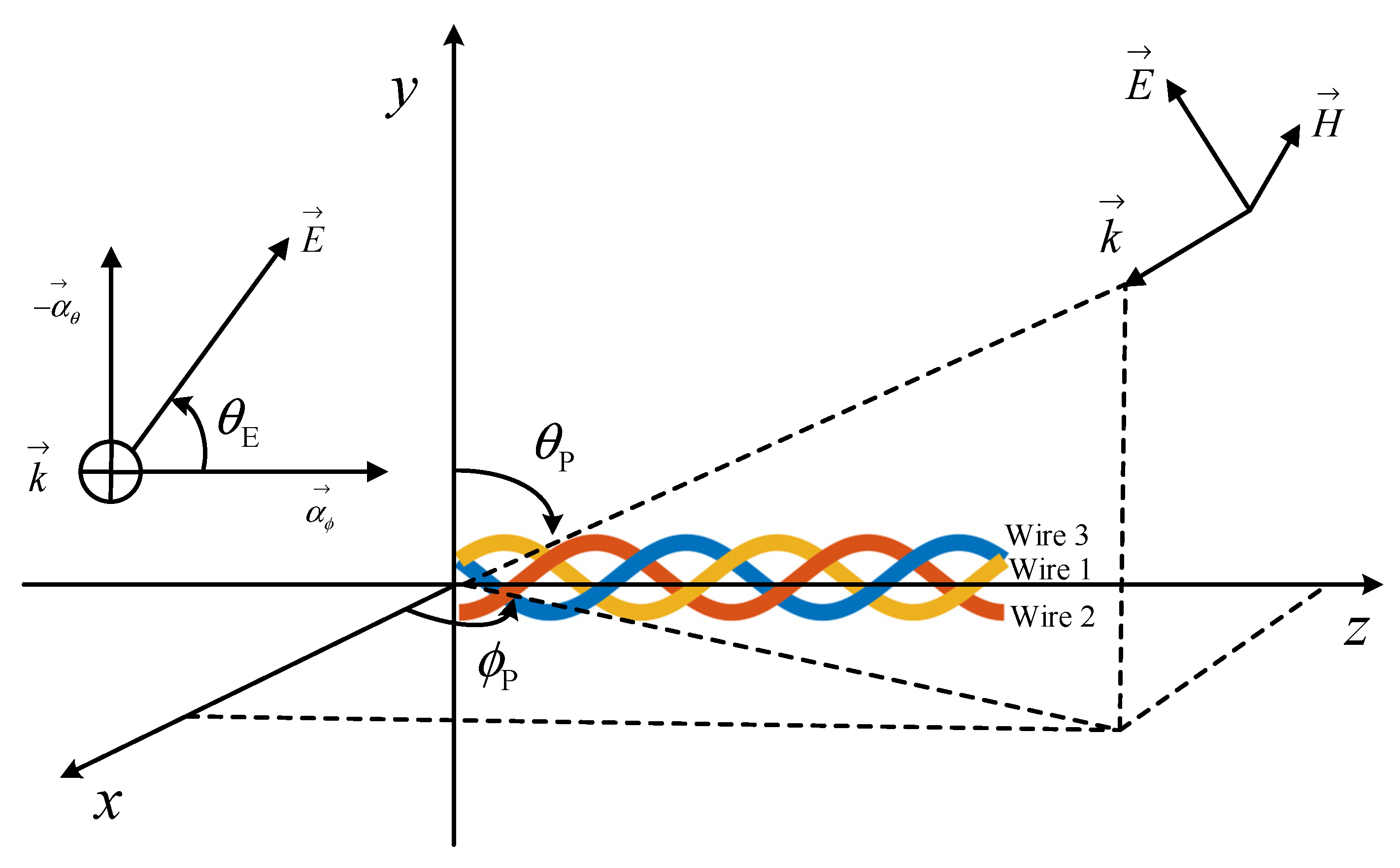

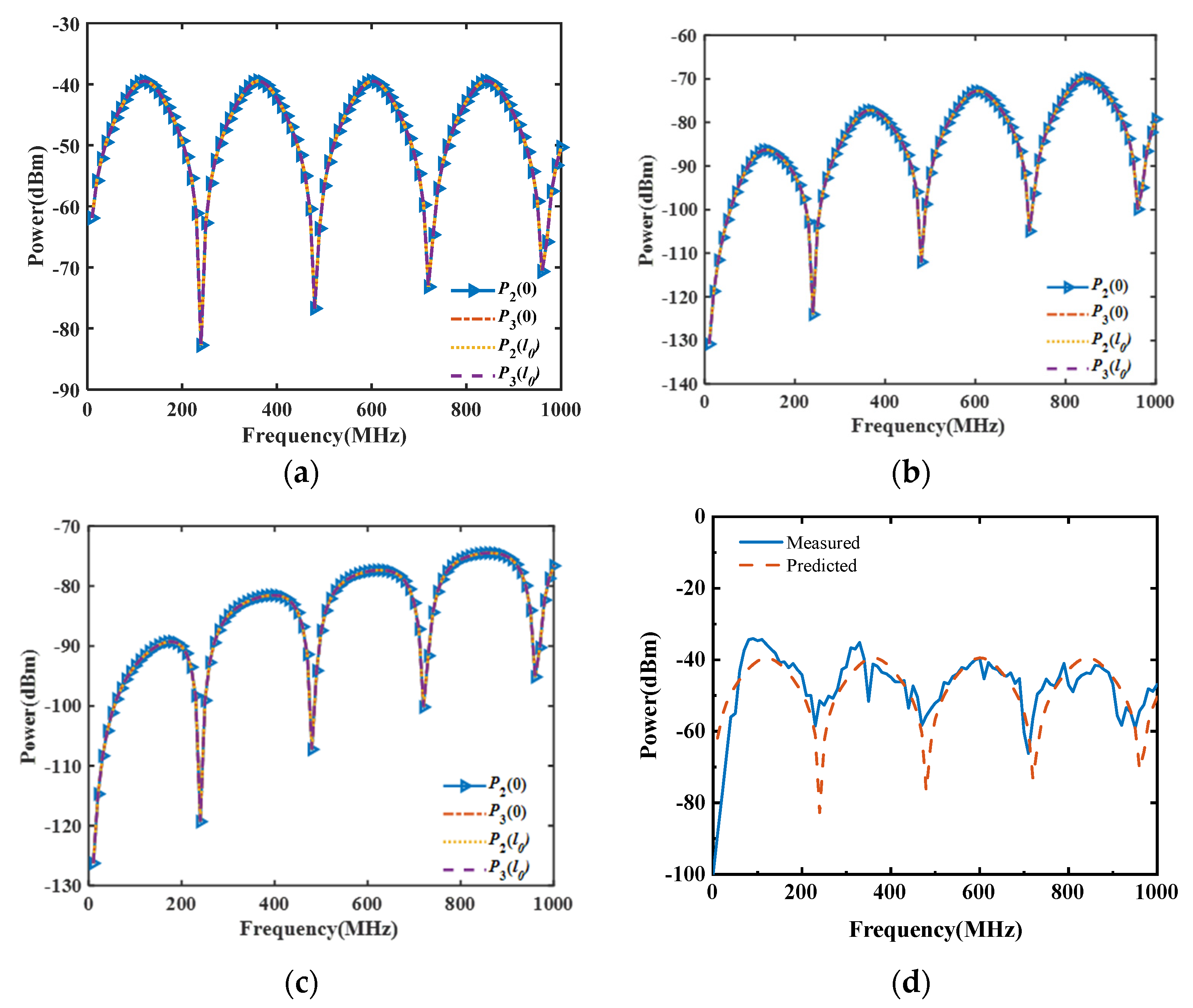

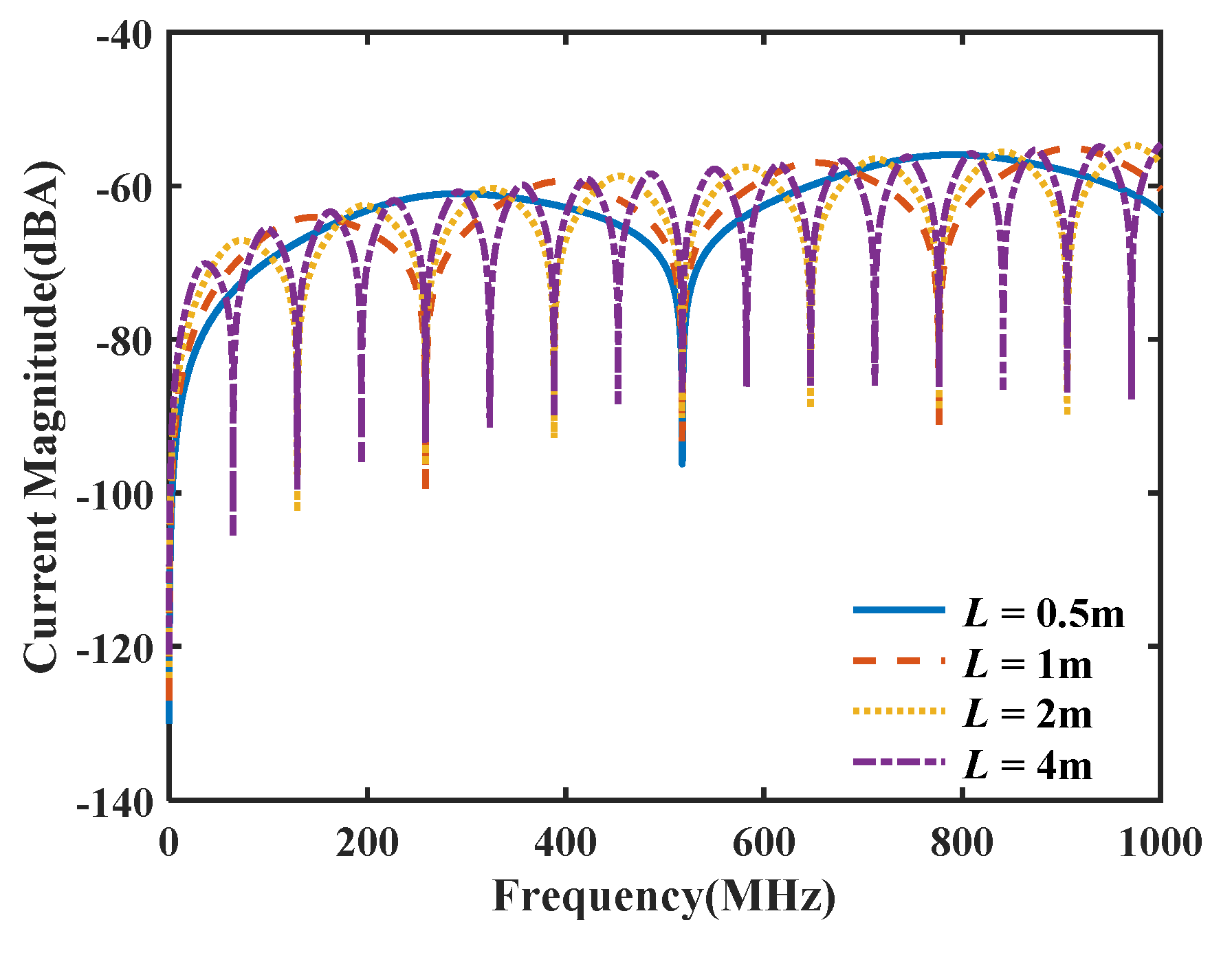
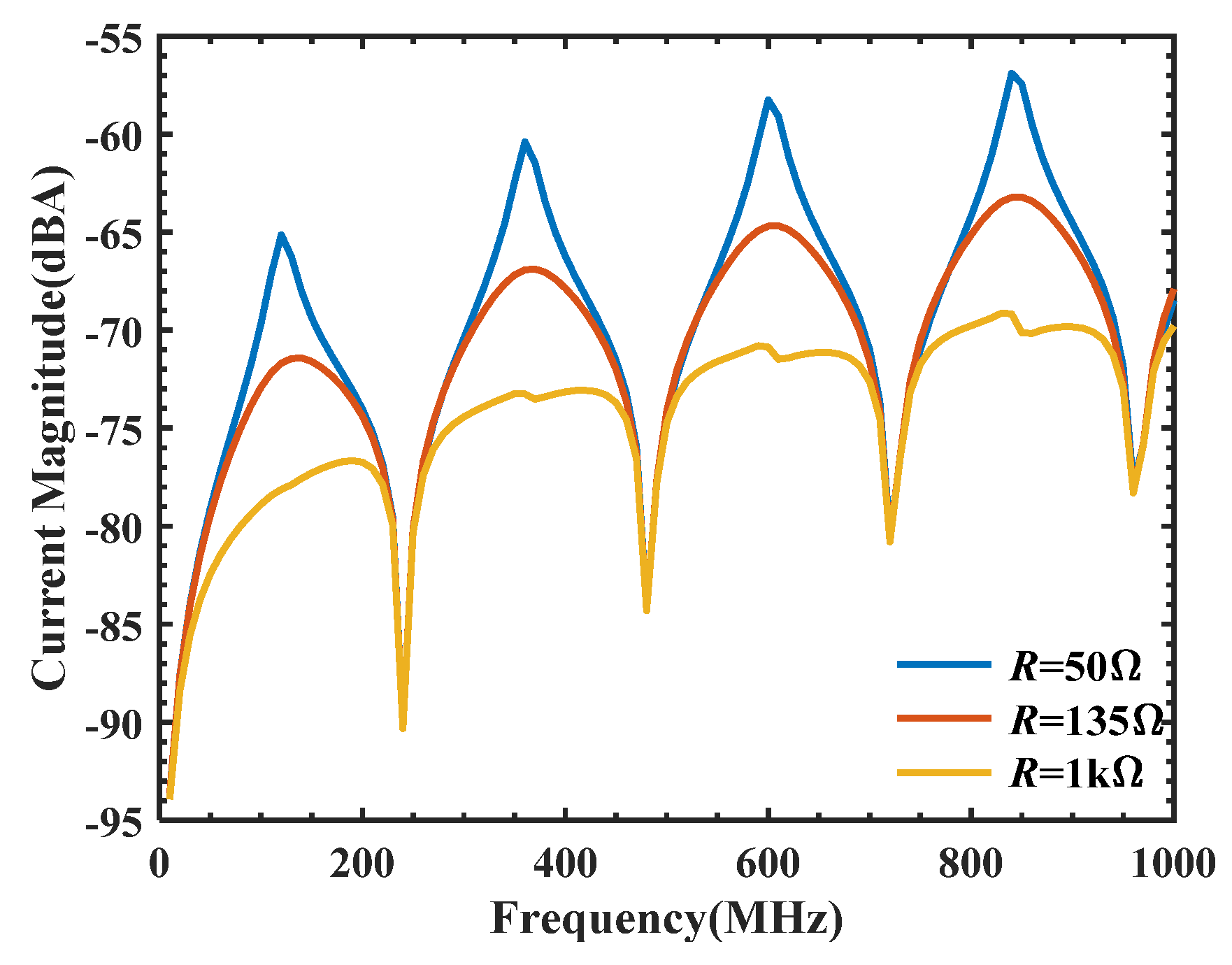
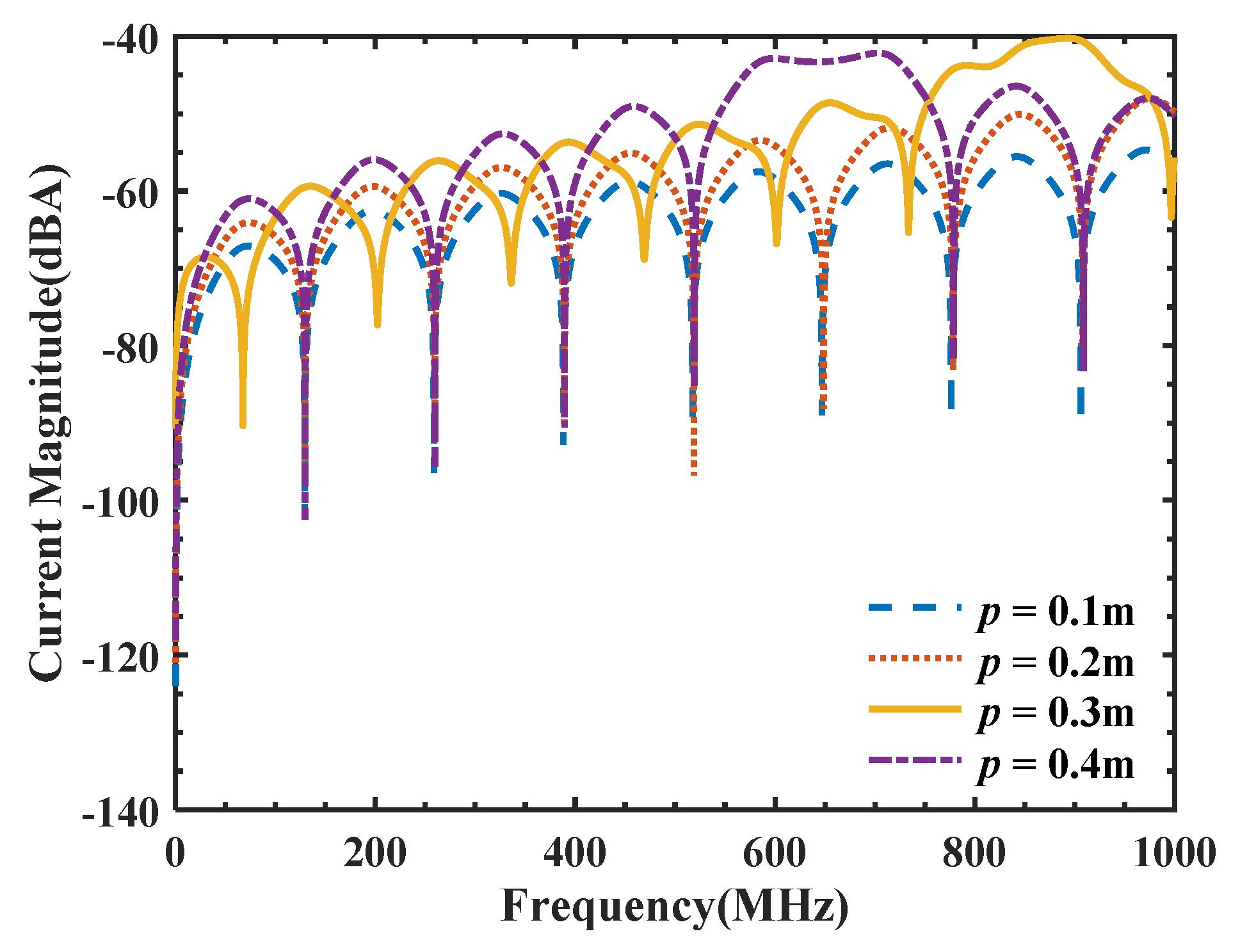
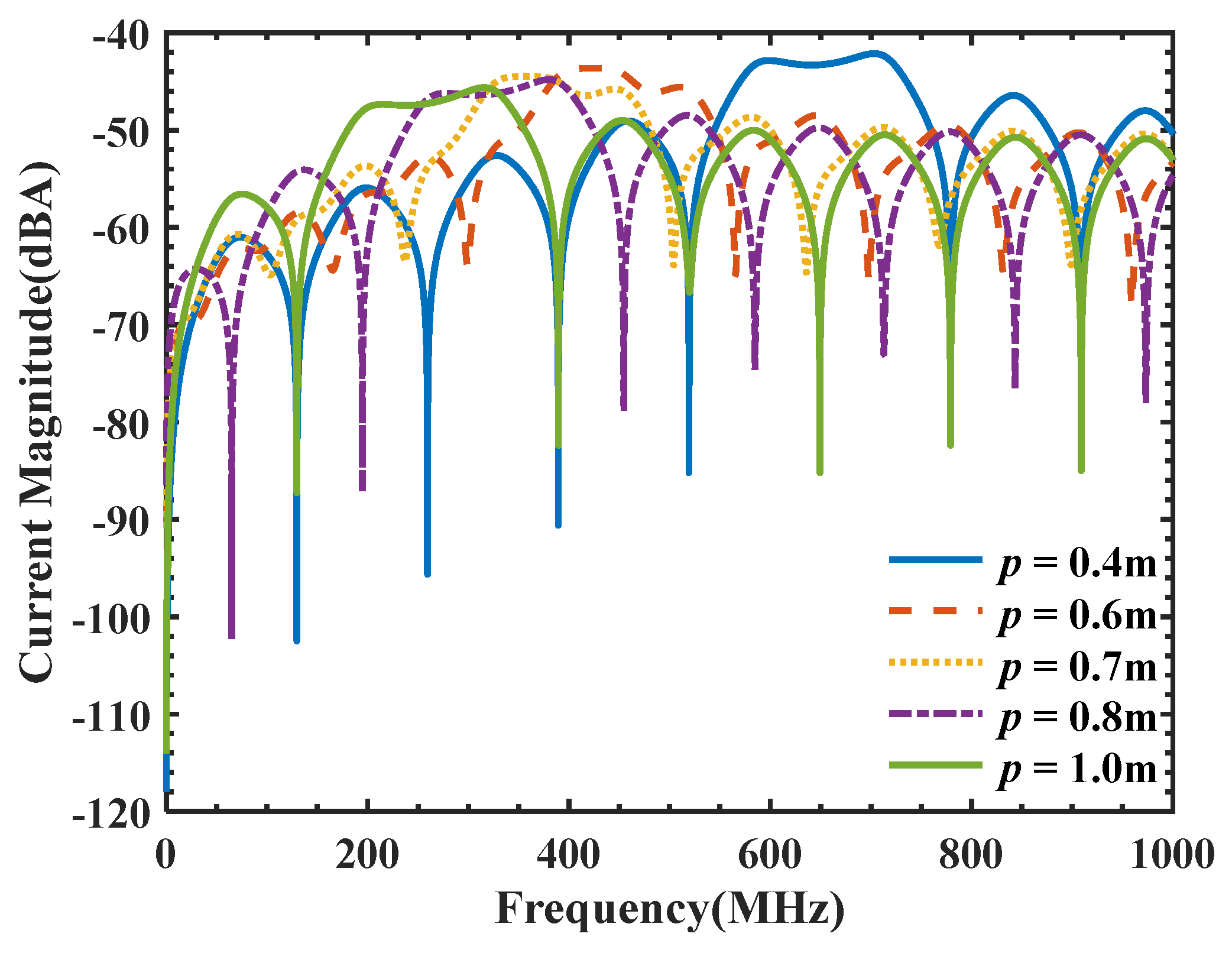
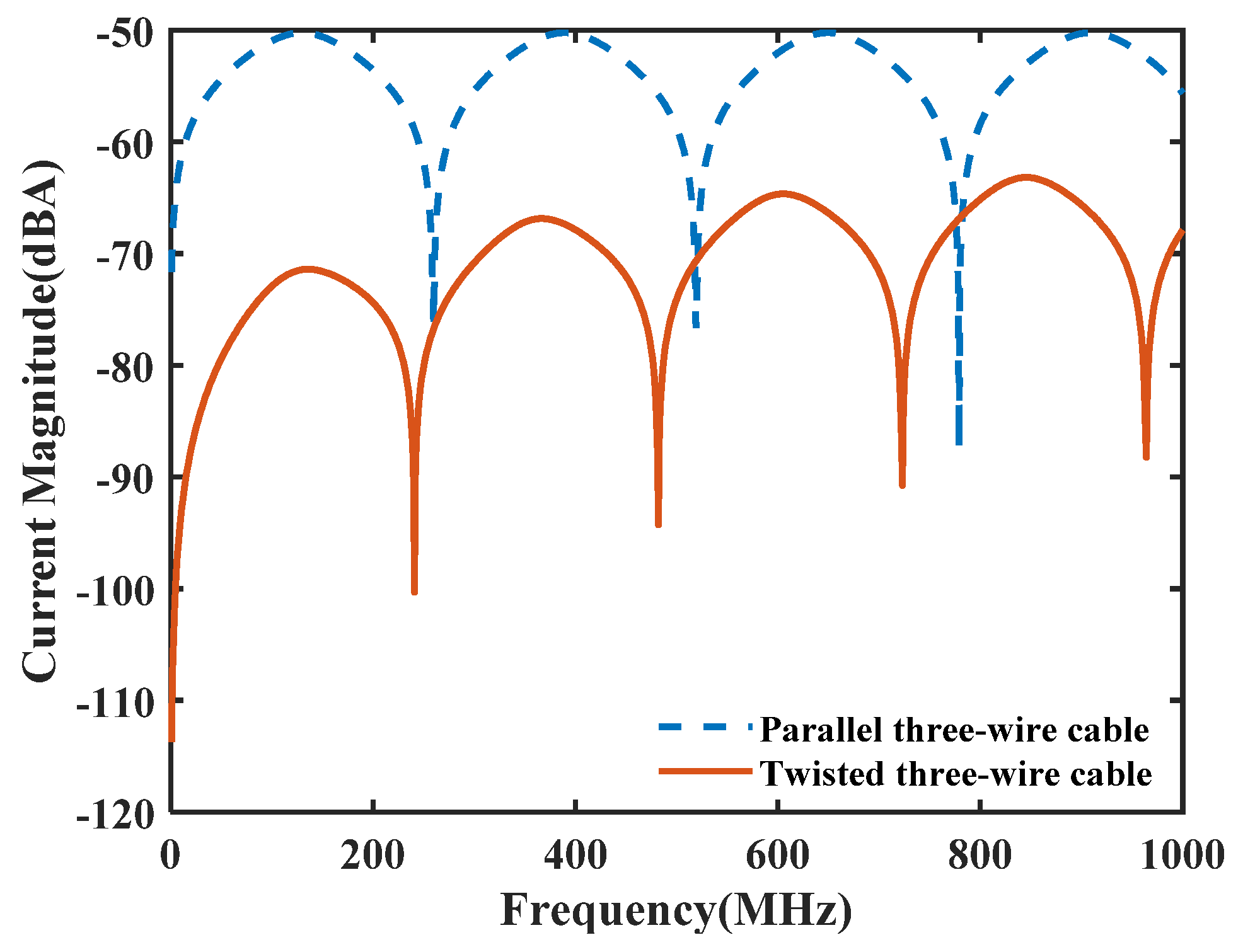
Disclaimer/Publisher’s Note: The statements, opinions and data contained in all publications are solely those of the individual author(s) and contributor(s) and not of MDPI and/or the editor(s). MDPI and/or the editor(s) disclaim responsibility for any injury to people or property resulting from any ideas, methods, instructions or products referred to in the content. |
© 2023 by the authors. Licensee MDPI, Basel, Switzerland. This article is an open access article distributed under the terms and conditions of the Creative Commons Attribution (CC BY) license (https://creativecommons.org/licenses/by/4.0/).
Share and Cite
Nie, Y.; Chen, Y.; Zhou, X.; Zhao, M.; Wang, Y. Analysis of the Terminal Response Characteristics of the Twisted Three-Wire Cable Excited by a Plane Wave Field. Electronics 2023, 12, 2018. https://doi.org/10.3390/electronics12092018
Nie Y, Chen Y, Zhou X, Zhao M, Wang Y. Analysis of the Terminal Response Characteristics of the Twisted Three-Wire Cable Excited by a Plane Wave Field. Electronics. 2023; 12(9):2018. https://doi.org/10.3390/electronics12092018
Chicago/Turabian StyleNie, Yaning, Yazhou Chen, Xing Zhou, Min Zhao, and Yan Wang. 2023. "Analysis of the Terminal Response Characteristics of the Twisted Three-Wire Cable Excited by a Plane Wave Field" Electronics 12, no. 9: 2018. https://doi.org/10.3390/electronics12092018
APA StyleNie, Y., Chen, Y., Zhou, X., Zhao, M., & Wang, Y. (2023). Analysis of the Terminal Response Characteristics of the Twisted Three-Wire Cable Excited by a Plane Wave Field. Electronics, 12(9), 2018. https://doi.org/10.3390/electronics12092018





